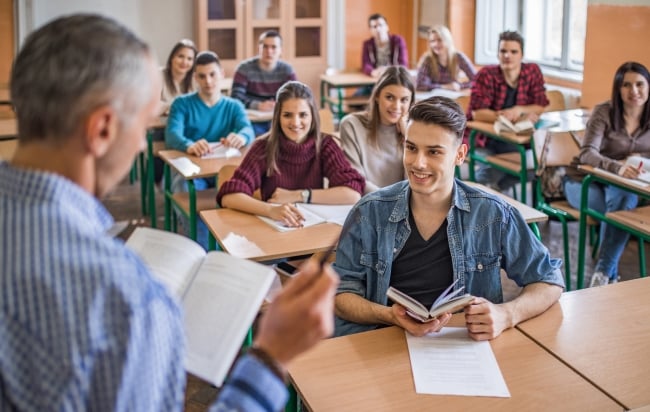You have /5 articles left.
Sign up for a free account or log in.

skynesher/E+/Getty Images
What began as a curiosity has become a core tenet of my teaching.
Due to complex medical conditions emerging from neurofibromatosis, I have worked remotely since March 2020. I often heard stories in 2020 and 2021 about guest speakers joining classes remotely and remained curious about innovative pedagogies inspired by the SARS/COVID emergency. I did not join the trend because I only teach asynchronously, and I tend to make changes only after long and careful thought.
However, the potential advantages—conversations between students and the authors they are reading or other experts that would help restore some human elements from our disconnectedness—continued to pique my interest.
In October 2022, I surveyed my 200 students to get some impressions. “Thinking about the future, would you or possibly students like you be interested in having a handful of sessions where we gather on Zoom to hear from a guest speaker?”
“Yes!” was the overwhelming response in the class GroupMe chat.
I then asked about scheduling. I explained that I knew no time would work for everyone, but I would like general ideas about the kind of schedules students had. With their help, we determined that 7 p.m. to 8 p.m. on a Monday, Tuesday or Wednesday would be the best time for most people after considering obligations related to school, family and work.
Thus, I launched what the not-so-creatively-named “The Live Sessions” in the spring of 2023. By reaching out to people I knew and to others I thought would be informative speakers, I scheduled four gatherings for my “Theologies from the Margins” course and three gatherings for my “Intersectionalities and Disability Studies” course.
The first session was for the Intersectionalities and Disability Studies class. I listed the event on the course calendar: “Mark your calendars for Tuesday, January 31, 2023, 7 p.m. to 8 p.m. CST. Four local activists, researchers and professors will join us on Zoom for a presentation and discussion about their personal experiences.”
It was a huge success. I had worried that students might refuse to participate in a synchronous activity for an asynchronous course. But 15 students were present. Most even turned on their cameras with ease. And the four guests provided engaging content about their lived experiences with visible and invisible disabilities and from the perspective of different genders, sexualities and races. The students asked great questions, too.
After the session, everyone had only had positive things to say. One speaker emailed, “Thank you all so much for this. I loved it.” A student wrote, “It was nice to see people with different backgrounds talk about something they all have in common. I also appreciated that I saw people who looked like me.” Students even requested an additional gathering of The Live Sessions, which we quickly scheduled.
For the Theologies from the Margins course, guests included feminist and Latinx theologians, a gay pastor, and an expert on religion and society. It’s one thing to read about liberation theology. It’s another to directly hear from and visit with someone who lives and practices different theological traditions.
The Live Sessions are a full sensory experience that especially benefits those who relate more to the screen than the written page. (And, in fact, even those students who cannot attend live seem to experience a similar benefit by seeing their classmates ask questions. It still makes the content more personal and more real.)
The groundwork that began with The Live Sessions proved especially useful and important following two on-campus suicides. My students were understandably upset and afraid. After reaching out to a friend and colleague who is an expert on suicide prevention as well as on the aftermath of suicide, I scheduled an emergency gathering of The Live Sessions with students from all of my classes invited.
The students in the courses were very engaged during the sessions, but I wished more students had been present for those sessions or watched the recording afterward. Thus, for the second part of my pilot, which occurred during the summer 2023, I attributed 5 percent of the grade to The Live Sessions. I required, as I described on the syllabus, “Active attendance during ‘The Live Sessions,’ or if you cannot attend live, actively watching the recording and writing a short paper within the week.”
With this change, half to two-thirds of students attended live. Most of the others watched the recording and wrote the short paper. Guests during the summer included authors whose work the students were reading, an ethnomusicologist and a chief state economist.
Throughout the spring and summer, students reported finding the sessions engaging, informative and inspiring. “I learned far more than I thought I would” was a regular refrain, along with, “I wish I had attended live!”
Thus, for fall 2023, I fully implemented The Live Sessions with 17 Zoom guest speakers for my 200 students spread across seven sections (five different classes). I invited all my student to attend any of the sessions if they wished, but I required them to attend the five specifically designated for their class.
A few data points underscore the success of The Live Sessions. During spring 2024, I hosted 16 different guest speakers with a total of 381 students present live. As many as 22 of 25 students attended a recent gathering live. I encouraged students in two of my recent classes to send a thank-you note to the author or speaker who taught them or touched them the most. Out of 37 students who participated, 27 sent their thank you message to one of our Zoom guest speakers.
A continuing challenge has been that I have no budget to pay guests or even offer a small honorarium. Even though I offer to return the favor, my inability to compensate them naturally limits who can be a volunteer speaker and whom I feel comfortable approaching. (That said, most creators and experts are enthusiastic about discussing their work!) It’s also a challenge to juggling the various courses, schedules and speakers involved. More recently, due to many students arriving as we start or even late and that causing a distraction, I have implemented an “on-time is five minutes early” rule and lock the meeting a few minutes after 7 p.m.
Minor challenges aside, The Live Sessions have continued to be a very successful cornerstone of my pedagogies for four semesters now. Importantly, despite a few challenges, this is a practice easily transferable to any course or institution, and I urge other faculty members to implement a version that works for you. The sessions are a blast for all involved and introduce students to new people and new ideas. Students see that activists, doctoral candidates, doulas, lawyers, novelists, poets, politicians, theologians and others are approachable and eager to peacefully exchange ideas. And over the semester, students realize that learning is far more dynamic and exciting than only reading textbooks. It’s an all-around win.








